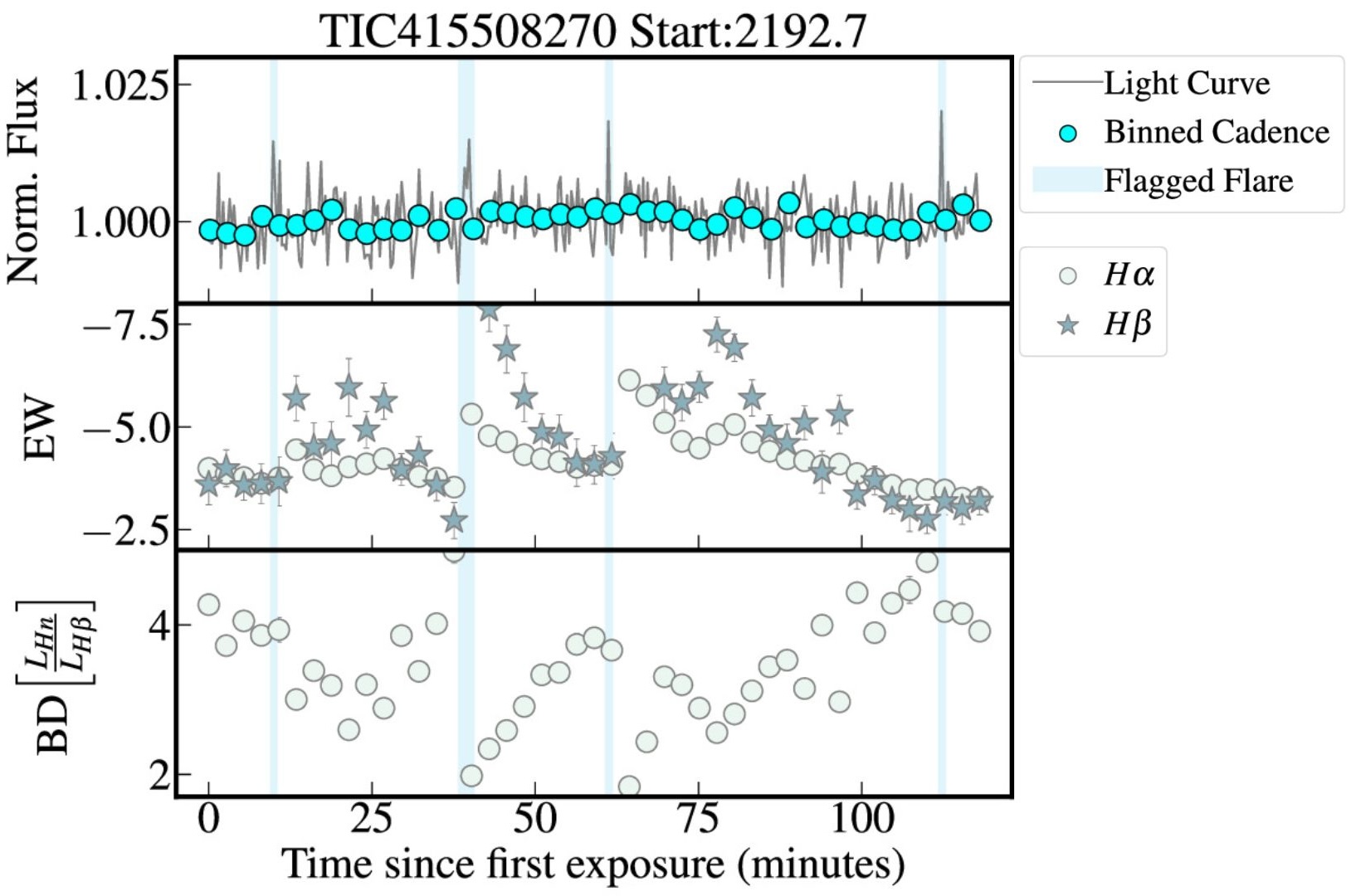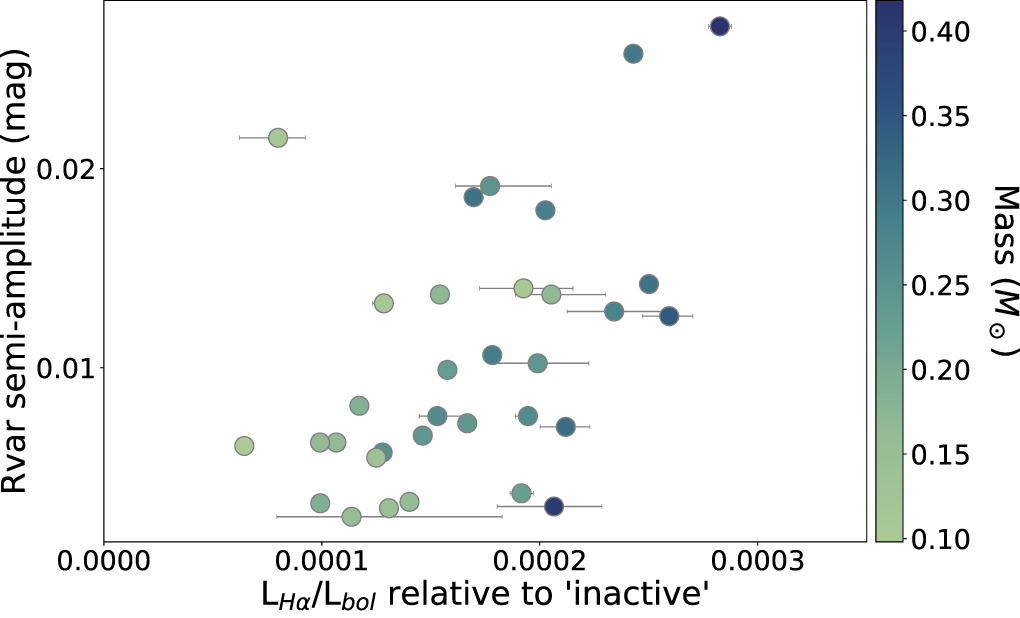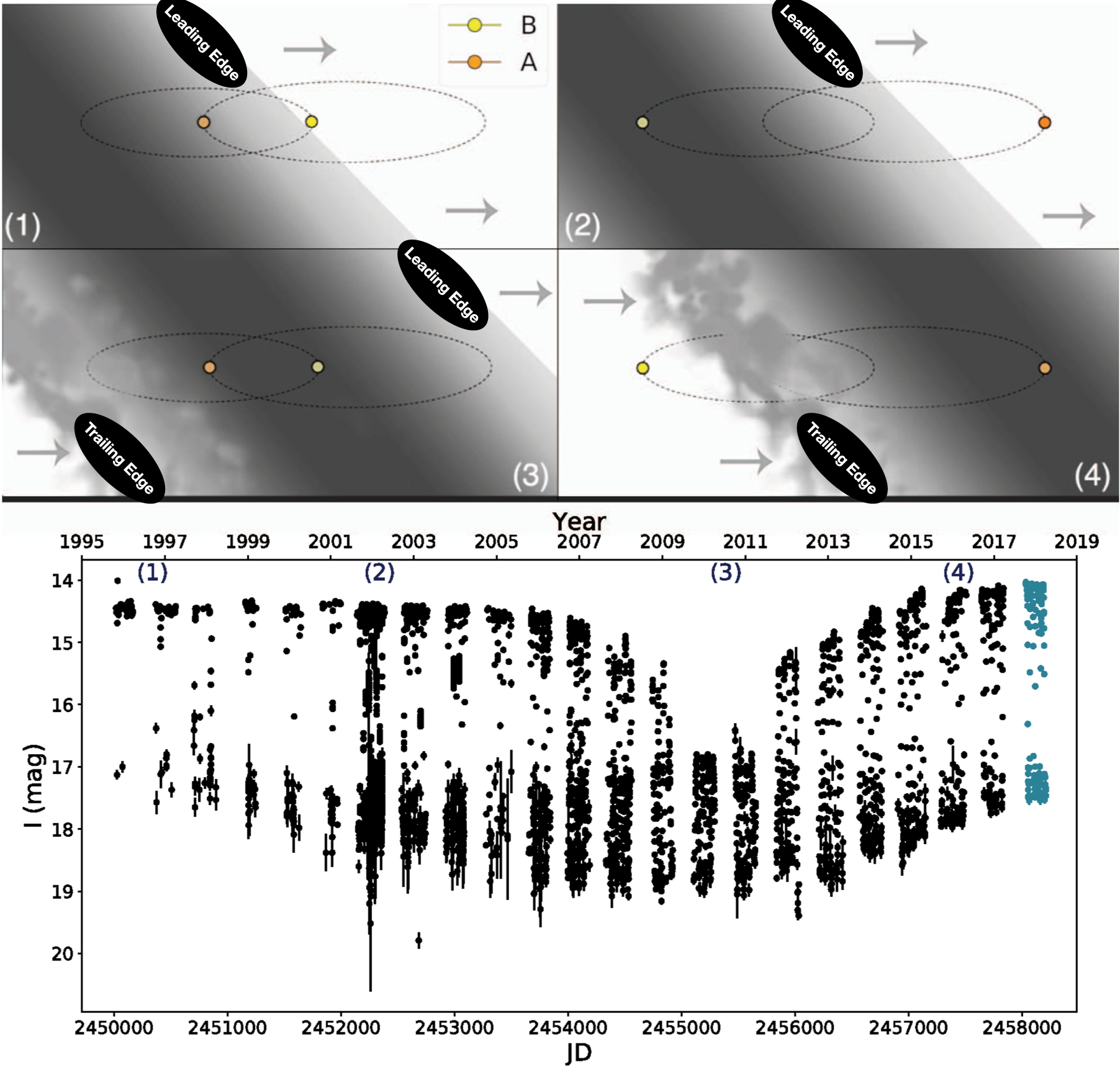Projects
Current projects that have been peer-reviewed and published in AAS Journals. They most recent publications focus on M dwarf variabilty, while the first paper looks at an K dwarf eclipsing binary system with precessing circumbinary disk.
M Dwarf Activity: Short-Term (~Flare Timescales) Balmer Emission Variability
In the literature there has evidence of short-term (15-60 minute) Hα variability (e.g. Lee et al. 2010, Bell et al. 2012, Medina et al. 2022, Duvvuri et al. 2023, Kumar et al. 2023). To learn more about the underlying physics and origin of Hα emission, we compared Hα stochastic short-term variability in dMs to other Balmer lines and contemporaneous flaring seen in the TESS light curves.
By comparing Balmer emission line variability (Hα, Hβ, Hγ, Hδ) to flare events detected in TESS light curves, we found that some cases, flares are observed in spectra but not in TESS light curves, and vice versa. While sometimes there was some indications of flares in TESS but stronger signals in the Balmer lines (Figure 3, only had Hα and Hβ). These discrepancies suggests that different physical mechanisms may underlie the flaring events detected in the different wavelengths. For example, the Balmer flare may correspond to a different wavelength regime light curve, or the flare was low energy and below TESS detectability.

While we were able to model (RADYN; Carlsson & R. F. Stein 1992 , 1995,1997, 2002, Allred et al. 2015, Carlsson et al. 2023) the flare energy for the complex Balmer flare in Figure 3, we were unable to constrain the photochemical radiation environment in detail. With a comprehensive multi-wavelength photometric analysis, we would be able to provide insights into why certain flares do not manifest across specific wavelengths.
Read Paper Here!M Dwarf Activity: Photometric Amplitude-Hα Emission Luminosity Relation
Photometric amplitude is a measure of brightness variations due to active regions like sunspots rotating in and out of view. Balmer emission lines, such as Hα, trace the heating of the star’s chromosphere, and both are correlated with the star's magnetic activity. In previous studies, a positive correlation was found between photometric amplitude and Hα luminosity, but with considerable scatter (Newton et al. 2017). This scatter was theorized in that paper be due to the non-simultaneity of data sets and the variability of magnetic activity cycles.
To address this, I conducted spectroscopic observations with the 2.4-meter and 1.3-meter telescopes at MDM Observatory in Arizona, in tandem with Transiting Exoplanet Survey Satellite (TESS) observations. For 35 fast-rotating stars of periods less than 10 days, and V magnitudes less than 17, the contemporaneous data show that the relationship between photometric amplitude and Hα luminosity is intrinsically scattered (Figure 2).

A possible explanations for the scatter could rely on differences in the origin of the Hα emission. For instance, with Ca II H&K, another chromospheric line that originates from collisional excitation (Cram & Mullan 1979), has shown to have a significant correlation with amplitude. This result is also important due to the dM studies that use Hα absorption or emission as an indicator for star-planet interactions interactions. While this can also be a mechanism for emission, it is important to note how complicated it is to pinpoint the origin of the emission even when compared to other chromospheric lines (Duvvuri et al. 2023).
Read Paper Here!V582 Mon (KH 15D) - T Tauri Binary System with Warped Circumstellar Disk
V 582 Mon (KH 15D; Kearns & Herbst 1998) is a young T Tauri binary system surrounded by a precessing dusty and warped circumbinary ring (e.g. Chiang & Murray-Clay 2004). The ring acts like an opaque screen with two occulting regions: the leading and trailing edge (e.g. Capelo et al. 2012, Windemuth & Herbst 2014, Arulanantham et al. 2016, 2017, Aronow et al. 2018). Since 1998, the screen has moved across the eclipsing binary system blocking several regions of the orbit (Figure 1).
The precession period based on a new model is thought to be 1200 yr with a ring radius of about 3.2 au. Furthermore, the leading edge has been reported to be "sharply defined" as opposed to the trailing edge which has evidence of transpancy in the optical and infrared using SMARTS/ANDICAM instrument. From extinction curves, the clumps might indicate dust of up to ~2μm (large relative to interstellar medium particles). Due variability in Star B magnitudes, there is now evidence of a spotted surface.
In Figure 1, we see four snapshots of the long-term light curve: 1. The leading edge blocked most of the orbit of Star B (Star B is thought to have been observed once around I = 14 mag), while Star A was occulted by the edge periodically. 2. The leading edge blocked the entirety of Star B, while A was occulted by the edge periodically. 3. The orbit of both stars were blocked, but we were still able to pick up some scattered light.

The trailing edge, a much clumpier region of the ring, is now occulting star B periodically while star A is still blocked. I created the Wikipedia page for this source (KH 15D Wikipedia Page).
Read Paper Here!